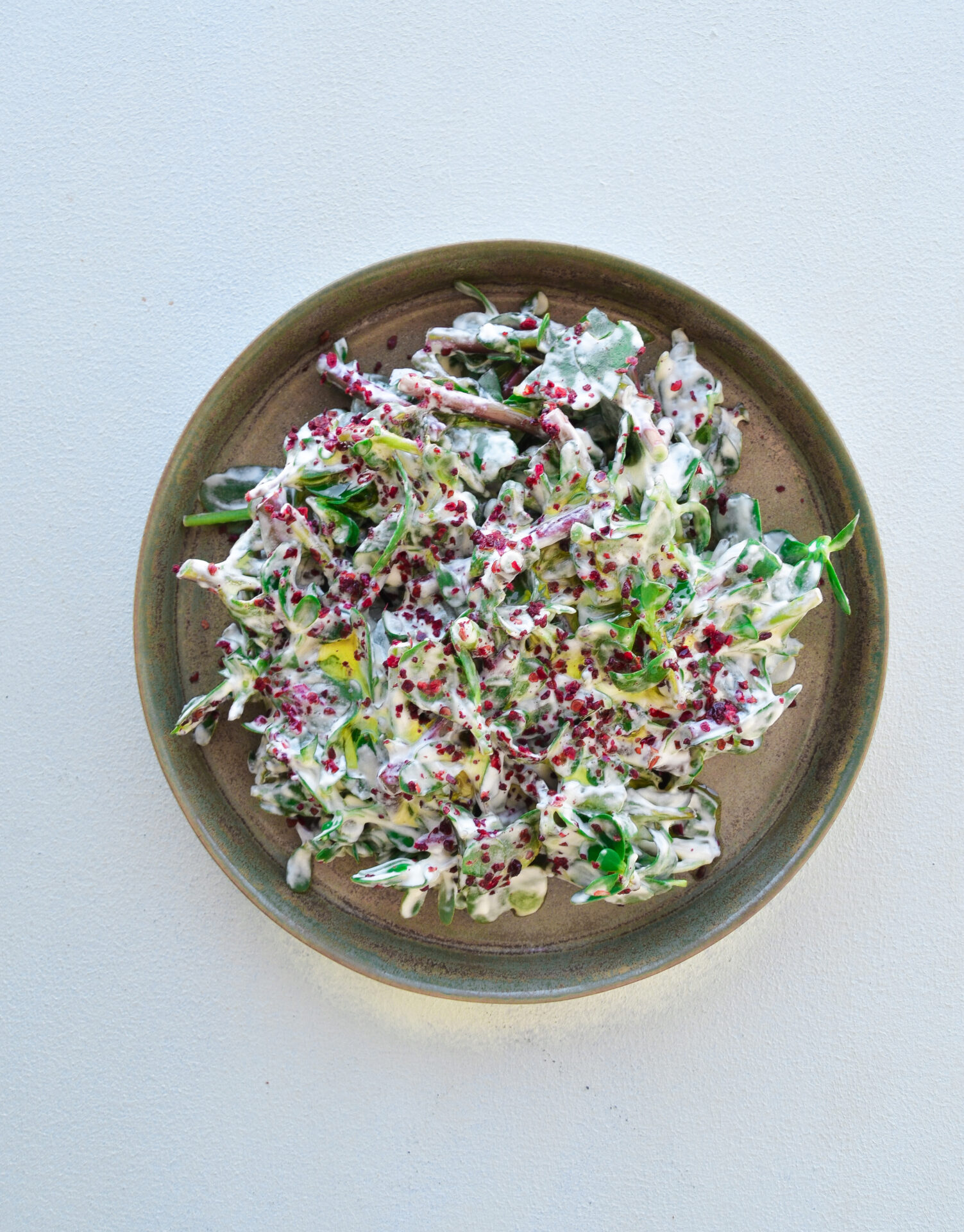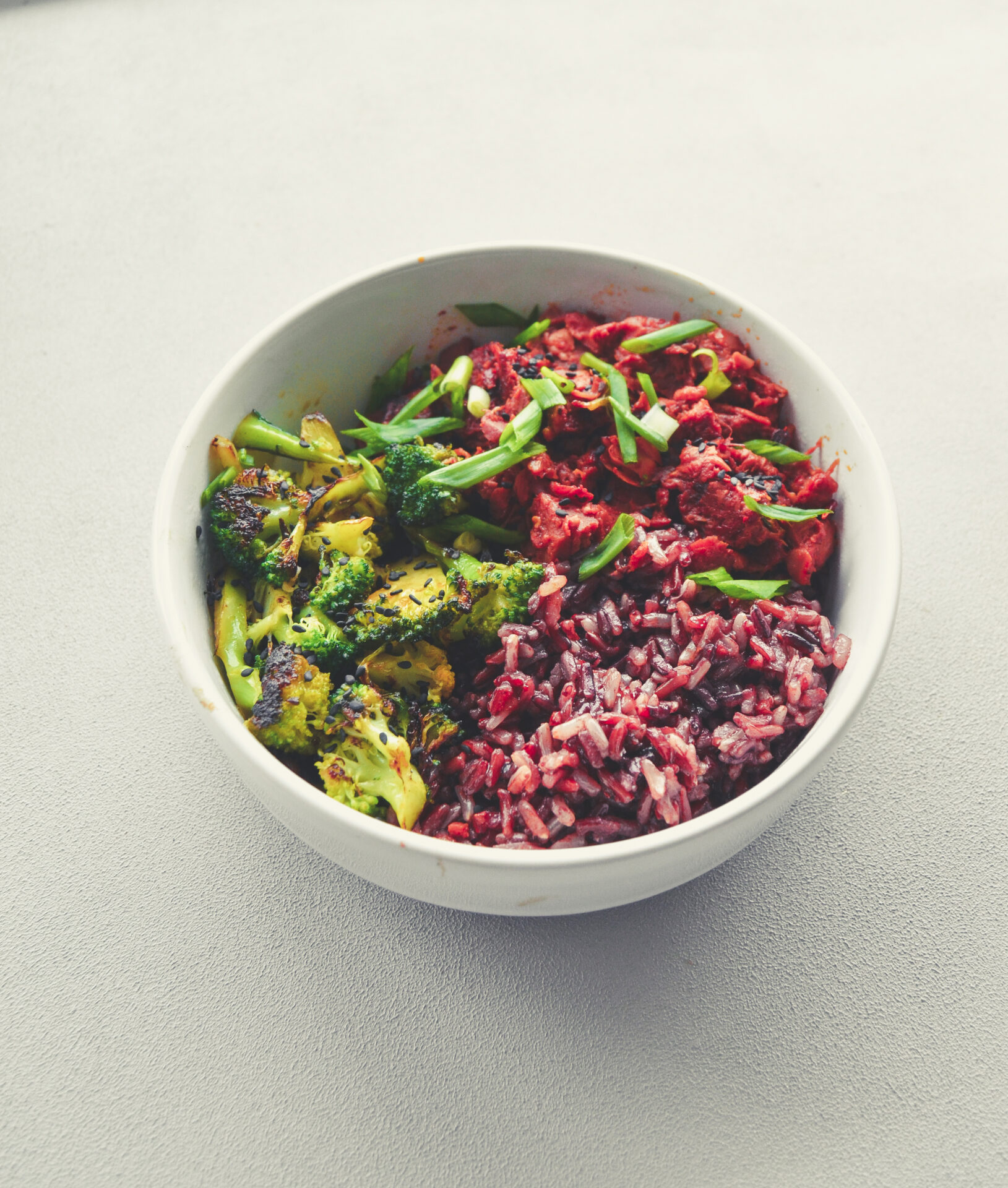

Ingredients
500 g fresh ripe tomatoes, preferably heirloom (firm and ripened ones.)
1/4 tsp salt + more if needed
Instructions
Chop tomatoes finely, place in a 20×20 cm square bowl. Add the salt, toss together.
Dehydrate at 46 C overnight or for about 6-8 hours. Stir it every two hours or so on.
Once dehydration process is up, check the consistency. You should get a thick paste-like tomato sauce. If not, using a strainer, remove the excess water and dehydrate another 1-2 hours or until you achieve the desired consistency.
Serve with your favorite bread or spread on the pizza dough. Drizzle some high quality balsamic(sugar-free), sprinkle some dulse flakes or whole dulse leaf, or your favorite seaweed and sesame seeds on top. Enjoy.
Notes:
Some tomatoes have more flavour than others! If available, choose firm tomatoes that have ripened. Juicy tomatoes take longer in the dehydrator.
This tomato sauce can also be used as the basis for tomato soup or a delicious raw gazpacho.


Ingredients
2 medium zucchini or courgettes
A handful of microgreens
2 cups gavur mountain
Instruction
1. To make curly zucchini noodles place the zucchini into spiralizer. Run to turn it into zoodle.
2. Make the gavur mountain salad according to instructions here.
3. Toss your zoodles with gavur mountain.
4. Sprinkle some micro greens.
5. Serve with raw bread if desired.



Raw tastes better if you dare to reset your taste buds!
Time: 9-10 hours
Makes: 3 dehydrator sheets (30x30cm x3)
Ingredients
635 g zucchini, peeled and chopped
Juice of 1 whole lemon +1/2 lemon juice
75 ml extra virgin olive oil (remove this if you are not using oil)
65 g red bell pepper
2 garlic cloves minced
50 g dried raisins soaked
115 g almond flour
90 g sprouted buckwheat flour
40 g sprouted teff flour
125 g flax seeds ( grind in coffee grinder before using)
15 g psyllium husk powder (use only in powder form)
1 tsp pink himalayan salt (optional. you can also use seaweed powder or celery powder instead salt)
Instructions
1. Peel and cut the zucchini and red bell pepper into chunks. Add to your food processor. Squeeze the lemon over the zucchini. Process until puree.
2. Add all the rest of ingredients (lastly add the psyllium husk powder) and process again until everything combined well.
3. Divide the mixture between 3 – 30×30 cm dehydrator sheets, using an offset spatula spread the mixture evenly to all four sides of the sheet carefully. Cut the mixture into 6 squares of desired size.
4. Dehydrate overnight or for about 8-10 hours until dried. After 3 hours of dehydration, flip the slices and remove the sheet. Continue to dehydrate. Once done, enjoy with your favorite toppings or salad. I love to make breakfast sandwich with this bread, it tastes great with simply mashed avocado, sliced raw onions, tomatoes, cucumber, collard greens and microgreen mix.
5. They can be stored in an airtight container in the refrigerator up tp 5-6 days. You may want to reheat them in the dehydrator before eating.


Gavour Mountain Salad (Gavurdağı Salatası) is a kind of Turkish panzanella without bread. The simplicity of the core ingredients lets you think that it is a dip; however, it is a refreshing salad. You can also use this finely chopped salad as a zoodle sauce (see here). It tastes amazing!
Ingredients
2 tbsp lemon juice
1 tbsp extra virgin olive oil
1/4 cup raw walnuts chopped
1 tbsp sumac
400 g tomatoes finely diced
1/2 bunch parsley finely chopped
1 medium onion finely chopped
2-3 spring onion finely chopped
1 large green pepper finely chopped
2 tbsp tamarind dissolved in lemon juice (the original gavurdağı salatası calls pomegranate syrup, if you use it make sure it is processed at low temperature, you can also use fresh pomegranates instead.)
Instructions
1. Chop all ingredients finel.
2. Mix the all the ingredients in a mixing bowl.
3. Drizzle pomegranate syrup or mix with tamarind paste.
4. Add some fresh lemon juice and extra virgin olive oil. Enjoy!


Purslane has countless benefits for our body. It carries high amount of Omega-3 fatty acids in it. It is the most Omega-3 rich green known among all others. So you don’t need to worry about Omega-3 when you quit eating fish, you can eat purslane. Chia and hemp are also high in omega-3 fatty. Make sure you include them in your diet.
This raw purslane salad is one of the freshest and super simple salads of Turkish cuisine. It is considered as either starter or meze at the restaurants. To make vegan version, you just need purslane leaves, plant-based yogurt (make yourself or use store-bought of your choice), garlic, sumac and olive oil.
Notes:
If you avoid using oil, just add lemon juice.
Sumac can also be replaced with cayenne or red pepper flakes.
Dried mint also goes well in this dish.
Ingredients
1 bunch fresh purslane (300g)
100 g fair trade cashews or macadamia ( you can also use peeled almonds, in this case add 1-2 tbsp olive oil as they are low in fat compared cashews or macadamias)
1/2 cup filtered water
Juice of whole lemon
1/2 tsp pink himalayan salt
1 large garlic clove minced
1 tbsp sumac to serve
Instructions
1. Cut off the roots of purslane bunces and wash and drain it well to make sure there is no soil left on the leaves. Use a salad spinner to remove any extra water drops on it. Then coarsely chop the purslane. Transfer in a mixing bowl.
2. Soak your nuts for 5 hours in warm water. Then strain and dry. Transfer to your high speed blender. Add the lemon juice, garlic, water and salt. Blend until silky smooth.
3. Add the purslane to the yogurt mixture and mix until all the purslane leaves are coated.
4. Transfer the salad to a serving plate, drizzle with olive oil if desired, and garnish with sumac.


Time: 20 minutes
Serves: 15 balls
Ingredients
120 g gluten-free rolled oats
40 g desiccated coconut
20 g raw cacao butter melted
90 g peanut butter
30 g coconut sugar
3 tbsp cold press coffee
A pinch of pink himalayan salt
30 g desiccated coconut for coating
Instructions
1. Melt the raw cacao butter using bain marie method.
2. Meanwhile, put the rolled oats and coconut sugar in a high speed blender. Process until combined and almost in powder form.
3. Then add the rest of the ingredients, blend to combine together.
4. Pour the raw cacao butter over the mixture. Mix everything until the dough perfectly holds together.You’ll see big ball in the food processor when it starts to get a dough shape.
5. Then remove from the food processor. Make 12 balls with your hands.
6. Roll in the desiccated coconut.


Serves 2
Ingredients
For the rice
140 g mixed Thai rice
1 tbsp tamari or coconut aminos
1 tbsp olive oil
3 springs of green onions chopped
For the jackfruit sauce
1 can young jack fruit meat
1 tbsp korean gochujang pepper paste
1 tbsp coconut sugar
3 tbsp freshly grated korean pear
1 tbsp freshly grated ginger
3 garlic cloves minced
1 tbsp olive oil
1 tbsp sesame oil
3 tbsp tamari
2 tsp sesame seeds to sprinkle
For the broccoli
200 g broccoli
1 tbsp olive oil
2 tbsp water
3 garlic cloves minced
Instructions
1. Cook your rice according the instructions on the package, lastly add the coconut aminos and olive oil. Using a fork, make fluffy.
2. In a pan whisk together grated ginger, garlic, pear, tamari, gochujang, coconut sugar, olive oil and sesame oil.
3. Pull the jackfruit with your hands. Add to the marinade and fold in until jackfruit is fully immersed in the sauce.
4. Heat a non-stick pan to medium-high heat. Put the jackfruit in the skillet.
5. Cook for about 3-4 minutes. Flip over letting it brown a bit, about another 3-4 minutes.
6. Transfer your rice and jack in the bowls. Sprinkle some sesame seeds.
7. Heat your pan again, add the olive oil and water, place the broccoli. Cook at medium-heat heat for about 3-4 minutes. Serve your broccoli with jack and rice. Sprinkle green onions on top. Enjoy!



Ingredients for the peach mixture
500 g ripe peach, cored
80 g coconut sugar
1 tsp cinnamon powder
1/2 tsp clove powder
1/4 tsp nutmeg powder
1 inch fresh ginger, minced
50 g raisins, soaked 1 hour
30 g pecans, soaked 8 hours and rinsed
20 g gluten-free rolled oats
Instructions
1.Roughly chop your peach and toss into a bowl with the rest of ingredients.
2.Let it sit to marinate while you make the dough.
Dough
1 tbsp coconut oil melted
1 tbsp psyllium husk powder
60 g maple syrup
100 g water
120 g almond flour
30 g coconut flour
40 g gluten-free oat flour
Instructions
1. Blend the almond flour, coconut flour, psyllium and oat flour together.
2. Add the rest of ingredients and knead with your hands to make a dough. Allow to set for a few minutes before rolling the dough.
3. Divide the dough into 3 balls, dust them with almond flour and place it between two pieces of parchment paper.
4. Using a rolling pin, roll it into a round, about a 1/4 inch thick.
5. Peel it off the paper and place on a new paper. Repeat with the rest of the dough.
6. Place about 3-4 tbsp of the peach mixture into the centre of the dough rounds and then form the dough up around it. Pinch it lightly to seal it.
7. Drizzle some of the leftover juices, if there are any, over the galettes. Dust some rolled oats and desiccated coconut if desired.
8. Dehydrate for 6-7 hours at 46 C, remove from the paper and place onto mesh for an additional 2 hours or until the crust is dry all round and the peach mixture is looking cooked.
9. Serve immediately with your favourite raw ice cream.

According to the Trade for Development Centre, only 3% of cashews sold on the world markets are Fair trade certified.
The process of cashews:
Women collect yellow cashew fruits in the southern countries, especially India, Ivory Coast and Vietnam.*
Once harvesting, the nuts have to be cut in half with special equipment. From that point, all of the work is done entirely by hand.
Women have to separate the actual nut from the skin, which contains toxic oils that burn skin and damage the eyesight. Unfortunately they are usually not provided with safety equipment such as gloves due to cost-cutting measures, which expose them to these toxins and influence their health.
In India meanwhile, the Daily Mail reported last year how,
“Burns are a fact of life for up to 500,000 workers in India’s cashew industry, nearly all women. They are employed without contracts, with no guarantee of steady income, no pension or holiday pay. Many don’t even get gloves, and if they did, they probably couldn’t afford to wear them. Gloves would slow their shelling down, and they are paid by the kilo.”
If we want to eat cashews and avoid value chains built on the back of human misery, we have only one option: pay more and get the fair trade one. Another option is to choose other nuts which are local or traveled shorter distances with less exploitation.
We love using oat milk as it is the least environmentally- and socially-problematic of the plant based milk alternatives.
*According to FAOSTAT figures reported by factfish, in 2017 world total production stood at 3,971,046 tons, of which Vietnam (863,060 tons), India (745,000 tons) and Ivory Coast (711,000) account for 58.3%.
Photograph: Maja Vujic





